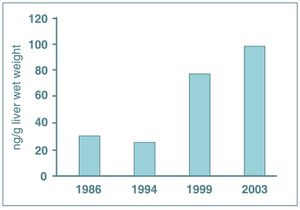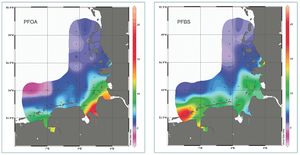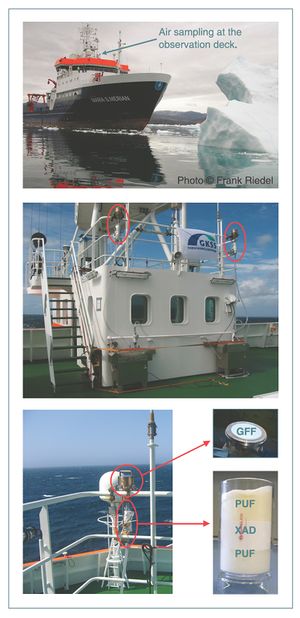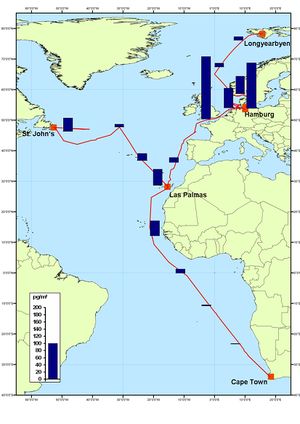Polyfluorinated compounds - a new class of global pollutants in the coastal environment
Contents
Introduction
Around the year 2000 a new class of chemical substances with toxic and persistent properties was detected in the environment - the polyfluorinated compounds (PFCs). At the Institute for Coastal Research scientific studies are performed on the PFC-contamination of coastal waters, marine mammals and the atmosphere with emphasis on the mechanisms of global transport and distribution of PFCs.
Polyfluorinated compounds have been industrially manufactured for over 50 years with global production currently reported to be in the order of thousands of tons per year. PFCs are used for surface treatment in carpets, textiles, leather and paper, in polymer production, fire-fighting foams, cosmetics and cleaning agents as well as in numerous other industrial and consumer applications
Nowadays PFCs are detected everywhere in the marine environment. As they resist degradation, possess toxic properties and bioaccumulate in the food web they are regarded as a new and emerging class of environmental contaminants. Furthermore PFCs are considered to be “candidates” for the Stockholm convention list of the so-called POPs (persistent organic pollutants). POPs are chemical substances that persist in the environment, are transported through air and water, across international boundaries, and deposit far from the place of release, where they accumulate in terrestrial and aquatic ecosystems. PFCs have the ability to repel both water and oil, which makes them suitable as surface-active substances. This surfactant-like character gives them the specific features desired by producers and consumers. About 350 polyfluorinated compounds of different chemical structures are known. The most discussed representatives of the PFC-group are the acids PFOA (perfluorooctanoate) and PFOS (perfluorooctane sulfonate) (Fig. 1).
Analysis of PFCs and levels of contamination
Although PFCs have already been produced for about half a century analytical detection in the environment is only possible with adequate instrumentation which has been available just for a few years. Low amounts of PFCs in soil, water, air and biota as well as their surfactant-like character require analytical methods with very low detection limits. The rapid development in the field of gas chromatography and high pressure liquid chromatography, both coupled with mass spectrometers, results in considerably lower detection limits and allows the determination of concentrations in the parts-per-billion-range and beneath. PFCs are man-made compounds. Currently, natural sources are not known. PFCs can be detected worldwide in almost all matrices of the environment. High amounts of PFOS and PFOA are found in food, human blood and human milk. Surprisingly high concentrations were determined in fish, seals, sea birds, and, most notably, in polar bears from the Arctic. Compared to other POPs like chlorinated hydrocarbons PFCs are found in higher ambient concentrations. In Swedish studies of human blood from 1997 to 2000 the mean PFC-concentration was 20 to 50 times higher than the concentration of the polychlorinated biphenyls and about 300 to 450 times higher than that of hexachlorobenzene, two classical organic pollutants, which are known to be hazardous (Kärrman et al., 2006[1]).
Temporal trend of PFC contamination

In the year 2005 Danish scientists published the results of their studies in seals from Greenland from 1982 to 2003. During this period PFOS concentrations in livers increased from about 30 ng/g to 100 ng/g wet weight (Bossi et al., 2005[2]) (Fig.2). At the GKSS Institute for Coastal Research the liver of a seal found in 2005 near the German island Amrum was analysed. It is worth remarking that PFOS concentration was about 20 times higher than the values determined in Greenland seals from 2003 although a direct comparison is problematic. Thus, the PFOS contamination of marine mammals not only increased during recent years but probably will also increase in the future. Within the framework of studies supported by the Scholarship Programme of the German Federal Environmental Foundation (Deutsche Bundesstiftung Umwelt, DBU) the livers of 80 seals from the Research and Technology Centre West Coast (FTZ) will be analysed by the GKSS Institute for Coastal Research. Analyses of PFCs will give information about changes in the contamination of seals over the last 20 years and allow for a reconstruction of the contamination of the North Sea in the past.
Air samples
Air samples were taken on board the German research vessel “Maria S. Merian” using high-volume air samplers located at the observation deck of the ship approximately 16 m above sea level. The air samplers were controlled by a computer connected to the ship’s meteorological system avoiding interference in the sampling by relative winds from aft. In general, 350 m³ of air were sampled. Glassfibre filters (GFF) and cartridges filled with a sandwich of polyurethane foam (PUF) and Amberlite XAD-2 resin were used to collect particle-bound (GFF) and gaseous (PUF/XAD) polyfluorinated compounds. The cartridges were extracted with acetone:methyl tert-butyl ether 1:1 without heating. The solvent was allowed to soak for a few hours, afterwards evaporated with ethyl acetate as a keeper and finally reduced to a few microlitres under a gentle stream of nitrogen. Filters were extracted using fluidised bed extraction with acetone:MTBE 1:1 to elute the neutral volatile polyfluorinated compounds like FTOHs and with methanol to elute the ionic perfluorinated carboxylic and sulfonic acids, respectively. During sampling and analyses, mass labeled compounds were used as internal and injection standards to correct for variations. Quantification of neutral compounds was performed by gas chromatography/mass spectrometry with positive chemical ionisation (PCI) using the selected ion monitoring (SIM) mode. Quantification of ionic compounds like PFOS and PFOA was made on an HPLC-ESI-MS/MS.
Distribution of PFCs in the environment
Studies at the Institute for Coastal Research confirm the assumption of two pathways of distribution of the acids PFOS and PFOA. The first way is the direct transport by water currents. In the year 2007 numerous water samples (between 1 and 5 L) were taken along the River Elbe, in the German Bight and in the Atlantic Ocean. After solid phase extraction and subsequent elution with organic solvents the extracts were analysed using high performance liquid chromatography-electrospray ionisation-tandem mass spectrometry (HPLC-ESI-MS/MS). In these samples 18 different PFCs were found. The concentrations were up to 20 ng/L, whereas the concentrations of dissolved PFOA and other perfluorinated carboxylic acids were higher in the estuaries of the River Elbe and the River Weser than in regions of the North Sea far away from the coast. Thus, these rivers were identified to be one of the sources of single certain PFCs for the German Bight (Fig. 3). On the other hand significant inputs of dissolved PFOS from the rivers Elbe and Weser could not be detected. To the west of the River Ems high amounts of PFBS (perfluorobutane sulfonate) were detected. At the end of 2006 very high amounts of PFBS were determined in water of the River Rhine. The source of this contamination was located in the Aare catchment area in Switzerland. For a few years PFBS has been used as a replacement chemical instead of PFOS, because in Europe the use of PFOS will be restricted effective from June 2008. In contrast to PFOS, its substitute PFBS is considered to be neither bioaccumulative nor toxic. But because of its persistence and its ionic character this short-chain PFC is rather mobile in the groundwater. Trace amounts were determined also in drinking water. However, PFBS is an unwanted man-made trace contaminant in the aquatic environment. The other pathway of global distribution is the transport via air. PFOS and PFOA are themselves non-volatile. But it might be possible that volatile precursor substances like fluorotelomer alcohols (FTOHs) (Fig. 4) can undergo long-range atmospheric transport. In the atmosphere these compounds physically degrade to PFOS and PFOA and subsequently are removed from the air to deposit on water or soil surfaces. This indirect transport results in a fast distribution of PFOS and PFOA over long distances. This hypothesis was the motivation for extensive investigations at the Institute for Coastal Research on the occurrence of polyfluorinated compounds in the atmosphere, their distribution patterns and the mechanisms of transport from their sources to pristine marine regions. Over the last three years a substantial number of air samples were taken in the North Sea, the Atlantic Ocean and the Arctic (Fig. 5). Several volatile precursor substances like fluorotelomer alcohols (FTOHs), fluorooctane sulfonamides (FOSAs), and fluorooctane sulfonamidoethanols (FOSEs) (Fig. 4) were detected in the gaseous phase of the air in the pg/m³ range of concentrations.
During the research cruises first concentration data sets of PFCs from the European atmosphere were generated. FTOHs were the dominating polyfluorinated compounds in all air samples. Highest concentrations of FTOHs (up to 200 pg/m³) were found at the European, northwest African and Canadian coasts of the North Sea and the Atlantic Ocean, respectively. But this group of compounds could be detected in the atmosphere also in regions far away from production and consumption like the Arctic or the southwest African coast of the Atlantic Ocean (Fig. 6). These results support the hypothesis of the long-range atmospheric transport of precursor substances. It is confirmed that transportation over long distances is theoretically possible (Ellis et al., 2003[3]). The atmospheric lifetime of FTOHs determined by its reaction with atmospheric OH radicals is approximately 20 days. The final product of this atmospheric degradation is PFOA. In analogy to FTOHs FOSEs degrade to the persistent end-product PFOS. In 20 days FTOHs will be transported over long distances downwind from its point of emission. Taking into account that the global average wind speed is 4 ms-1 which corresponds to 13.8 km h-1 an air mass travelling at this speed covers 7000 km in 20 days. PFOA and PFOS produced in the course of this atmospheric process are removed from the air by precipitation, are deposited onto the ocean or land surfaces, or are ingested by organisms and accumulated in the food chain. Thus, both pathways are involved in the global occurrence and distribution of PFOS and PFOA.
Further reading (more recent references)
Lindstrom, A.B., Strynar, M.J. and Libelo, E.L. 2011. Polyfluorinated Compounds: Past, Present, and Future. Environ. Sci. Technol. 45: 7954–7961
EPA: What are PFCs and How Do They Relate to Per- and Polyfluoroalkyl Substances (PFASs)?
EPA: PFAS Laws and Regulations
UNEP 2013: SYNTHESIS PAPER ON PER- AND POLYFLUORINATED CHEMICALS (PFCS)
OECD: Portal on per and poly fluorinated chemicals
References
- ↑ Kärrman, A., Bert van Bavela, B., Järnbergb, U., Hardella, L. & Lindström, G. (2006). Perfluorinated chemicals in relation to other persistent organic pollutants in human blood, Chemosphere, 64, 1582-1591.
- ↑ 2.0 2.1 Bossi, R., Riget, F.F. & Dietz, R. (2005). Temporal and spatial trends of perfluorinated compounds in ringed seal (Phoca hispida) from Greenland. Environmental Science and Technology 39 (19), 7416-7422. Cite error: Invalid
<ref>tag; name "B" defined multiple times with different content - ↑ Ellis, D.A., Martin, J.W., Mabury, S.A., Hurley, M.D., Sulbaek Andersen, M.P. & Wallington, T.J. (2003). Atmospheric lifetime of fluorotelomer alcohols. Environmental Science and Technology 37 (17), 3816-3820.
Please note that others may also have edited the contents of this article.
|
Please note that others may also have edited the contents of this article.
|
Please note that others may also have edited the contents of this article.
|
Please note that others may also have edited the contents of this article.
|


